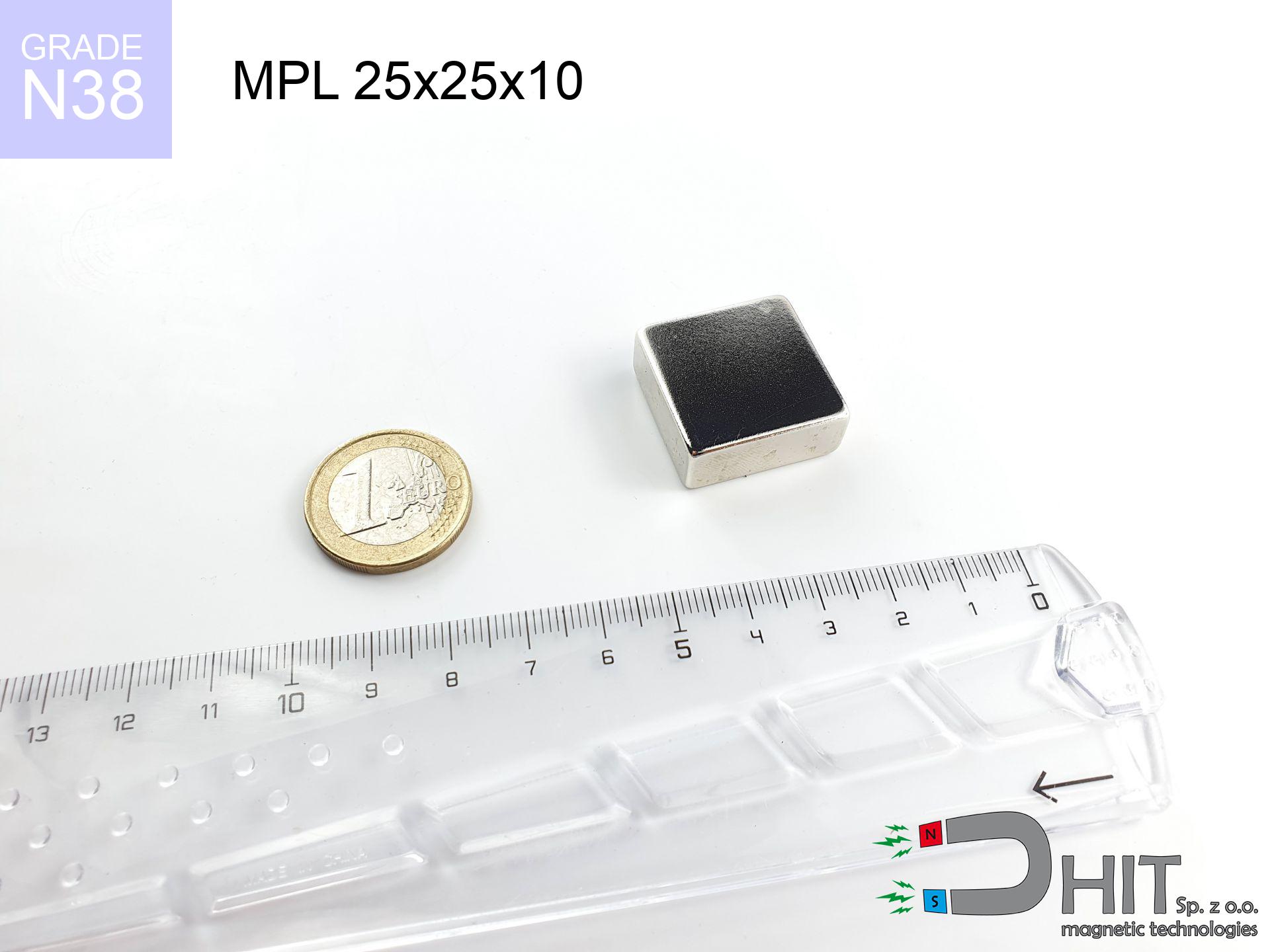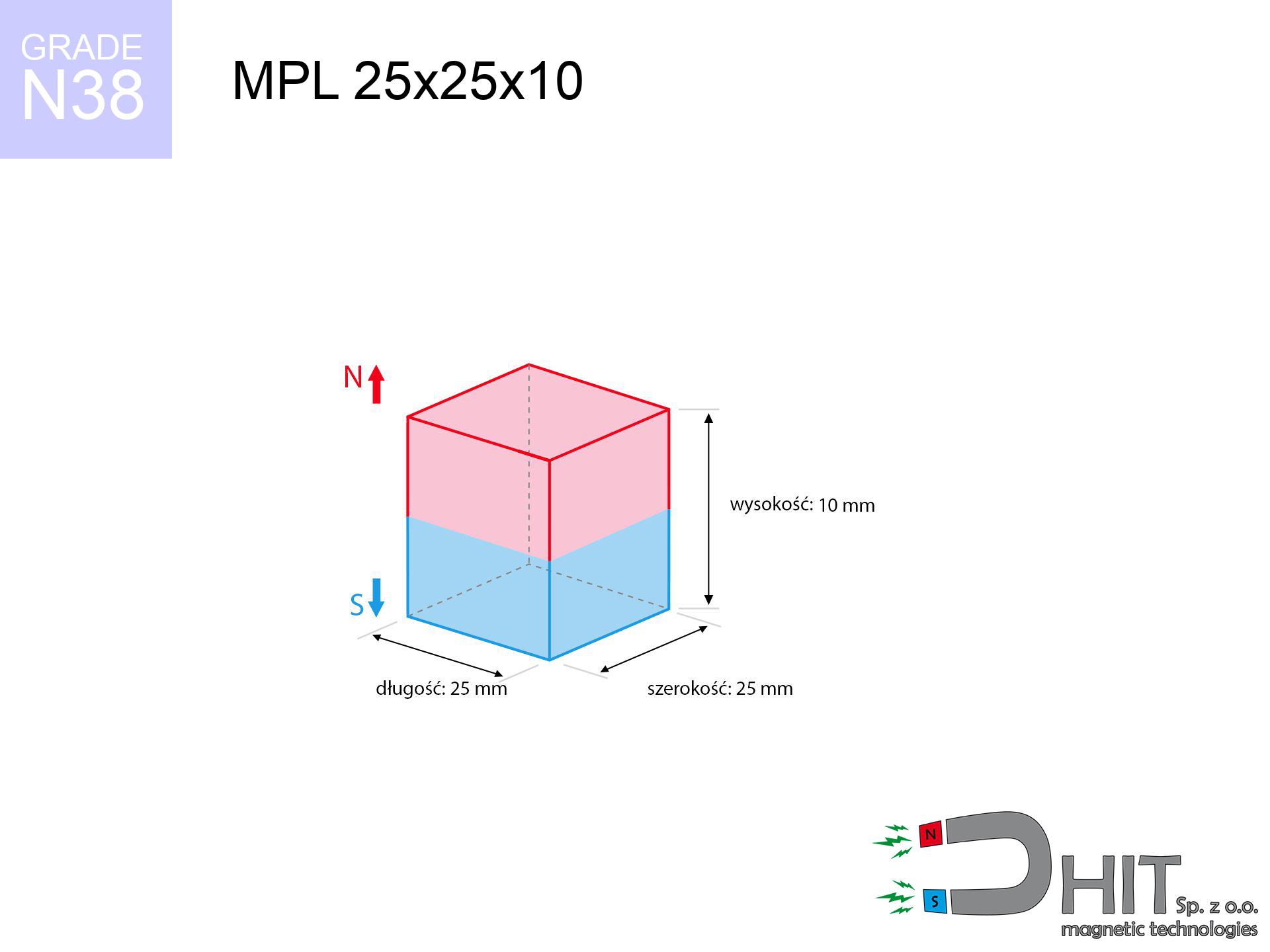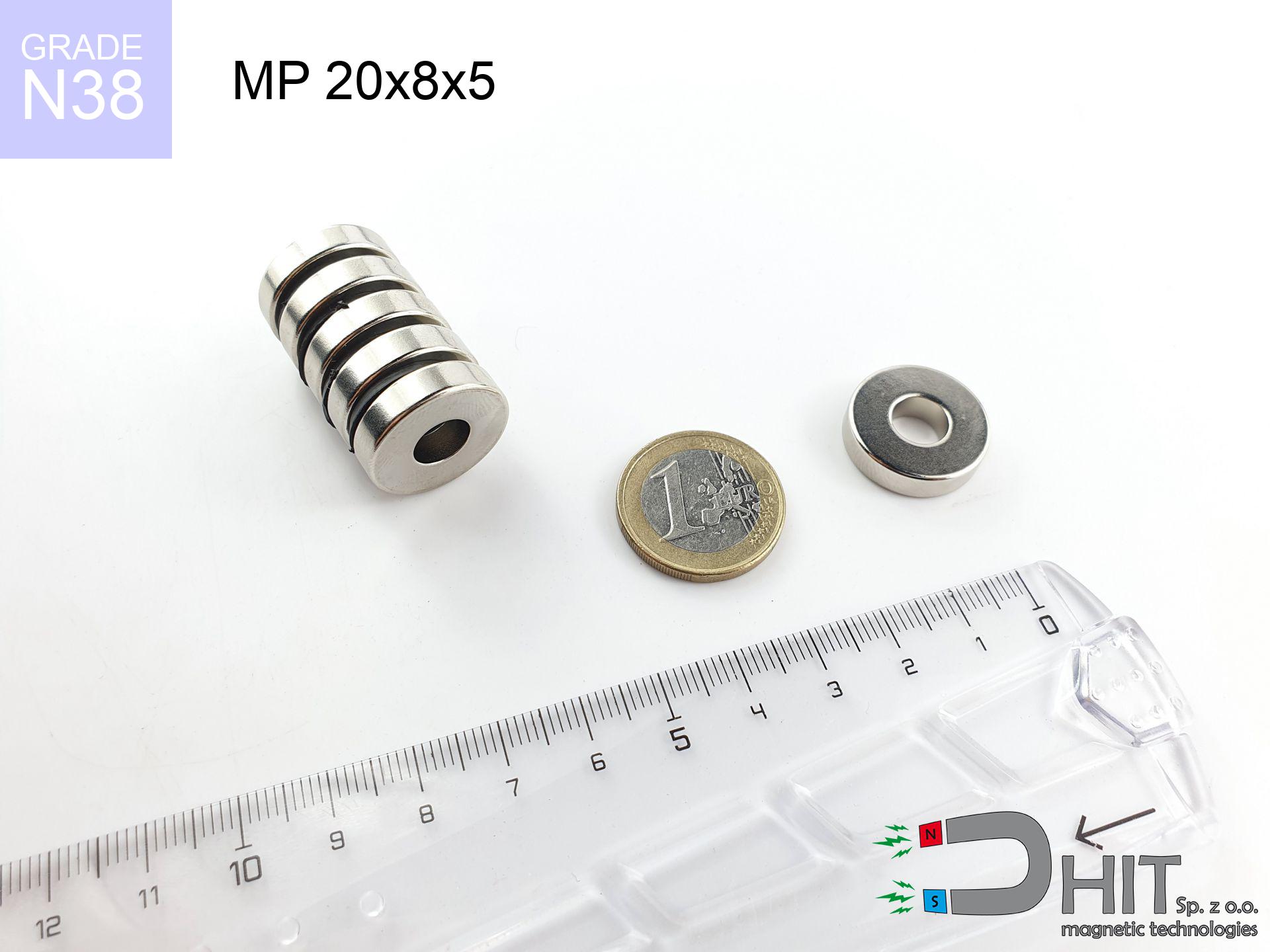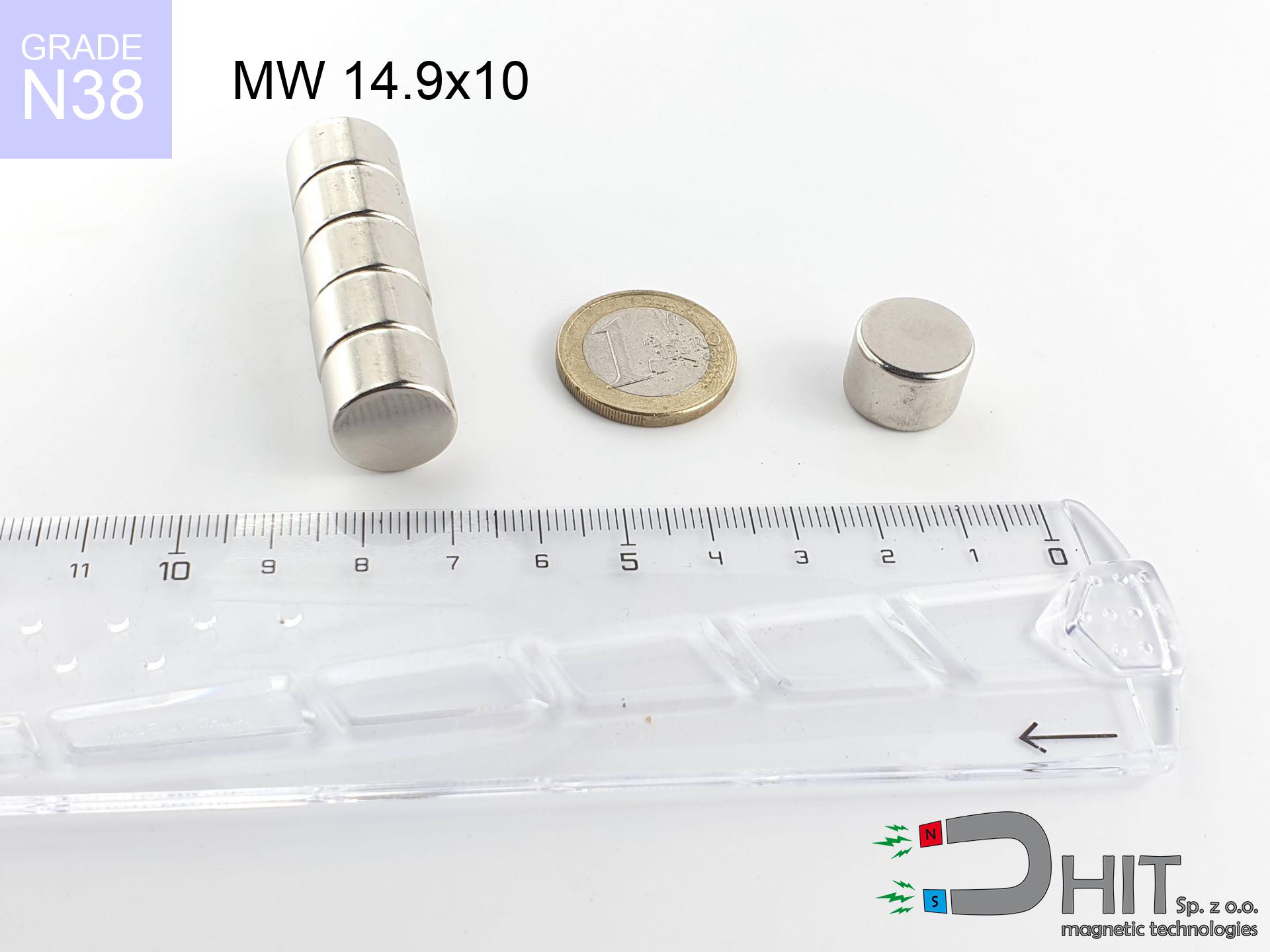MPL 25x25x10 / N38 - neodymium magnet
lamellar magnet
catalog number 020137
GTIN: 5906301811435
length
25
mm [±0,1 mm]
width
25
mm [±0,1 mm]
height
10
mm [±0,1 mm]
magnetizing direction
↑ axial
capacity ~
19.74 kg / 193.58 N
magnetic induction ~
361.04 mT / 3,610 Gs
max. temperature
≤ 80
°C
catalog number 020137
GTIN: 5906301811435
length
25 mm [±0,1 mm]
width
25 mm [±0,1 mm]
height
10 mm [±0,1 mm]
magnetizing direction
↑ axial
capacity ~
19.74 kg / 193.58 N
magnetic induction ~
361.04 mT / 3,610 Gs
max. temperature
≤ 80 °C
12.77 ZŁ gross price (including VAT) / pcs +
10.38 ZŁ net price + 23% VAT / pcs
bulk discounts:
need more quantity?Don't know what to buy?
Give us a call tel: +48 888 99 98 98 or write through contact form on our website. You can check the mass and the appearance of neodymium magnets in our magnetic calculator power calculator
Orders placed by 2:00 PM will be shipped on the same business day.
Specification: lamellar magnet 25x25x10 / N38 ↑ axial
Magnetic properties of the material N38
Physical properties of sintered neodymium magnets Nd2Fe14B
Thanks to their mighty power, flat magnets are regularly used in products that require very strong attraction.
Typical temperature resistance of flat magnets is 80 °C, but with larger dimensions, this value rises.
Moreover, flat magnets commonly have special coatings applied to their surfaces, such as nickel, gold, or chrome, to increase their durability.
The magnet with the designation MPL 25x25x10 / N38 and a magnetic strength 19.74 kg which weighs a mere 46.88 grams, making it the perfect choice for applications requiring a flat shape.
Contact surface: Due to their flat shape, flat magnets ensure a greater contact surface with adjacent parts, which can be beneficial in applications requiring a stronger magnetic connection.
Technology applications: These are often utilized in various devices, e.g. sensors, stepper motors, or speakers, where the flat shape is important for their operation.
Mounting: Their flat shape makes mounting, particularly when it is required to attach the magnet to some surface.
Design flexibility: The flat shape of the magnets gives the possibility designers greater flexibility in placing them in structures, which is more difficult with magnets of more complex shapes.
Stability: In certain applications, the flat base of the flat magnet may provide better stability, reducing the risk of sliding or rotating. It’s important to keep in mind that the optimal shape of the magnet is dependent on the specific project and requirements. In some cases, other shapes, such as cylindrical or spherical, are a better choice.
Magnets have two poles: north (N) and south (S), which attract each other when they are oppositely oriented. Similar poles, e.g. two north poles, act repelling on each other.
Due to these properties, magnets are commonly used in electrical devices, e.g. motors, speakers, sensors, or magnetic locks. Neodymium magnets stand out with the greatest strength of attraction, making them indispensable for applications requiring powerful magnetic fields. Additionally, the strength of a magnet depends on its size and the materials used.
It’s worth noting that high temperatures can weaken the magnet's effect. The Curie temperature is specific to each type of magnet, meaning that once this temperature is exceeded, the magnet stops being magnetic. Interestingly, strong magnets can interfere with the operation of devices, such as compasses, credit cards or electronic devices sensitive to magnetic fields. For this reason, it is important to avoid placing magnets near such devices.
Product suggestions
Advantages as well as disadvantages of neodymium magnets NdFeB.
In addition to immense power, neodymium magnets have the following advantages:
- They do not lose strength over time. After approximately 10 years, their power decreases by only ~1% (theoretically),
- They protect against demagnetization caused by external magnetic field extremely well,
- By applying a shiny coating of nickel, gold, or silver, the element gains an aesthetic appearance,
- They exhibit very high magnetic induction on the surface of the magnet,
- Magnetic neodymium magnets are characterized by very high magnetic induction on the surface of the magnet and can operate (depending on the shape) even at temperatures of 230°C or higher...
- Thanks to the flexibility in shaping or the ability to adapt to specific requirements – neodymium magnets can be produced in many variants of shapes and sizes, which amplifies their universality in usage.
- Key role in advanced technologically fields – are used in computer drives, electric motors, medical equipment and various technologically advanced devices.
Disadvantages of neodymium magnets:
- They are fragile when subjected to a strong impact. If the magnets are exposed to impacts, we recommend using magnets in a metal holder. The steel housing in the form of a holder protects the magnet from impacts and at the same time increases its overall strength,
- High temperatures can reduce the strength of neodymium magnets. Typically, after heating above 80°C, most of them experience a permanent loss in strength (although it is dependent on the shape and size). To prevent this, we offer special magnets marked with the symbol [AH], which are highly resistant to high temperatures. They can operate even at temperatures up to 230°C, making them an ideal solution for applications requiring high-temperature operation,
- Magnets exposed to a humid environment can corrode. Therefore, when using them outdoors, we recommend using waterproof magnets made of rubber, plastic, or other moisture-resistant materials,
- The use of a cover or a magnetic holder is recommended due to the limited possibilities of manufacturing threads or complex shapes in the magnet
- Health risk associated with microscopic parts of magnets are risky, when accidentally ingested, which becomes significant in the context of child safety. Furthermore, small elements of these magnets can hinder the diagnostic process when they are in the body.
Safety Guidelines with Neodymium Magnets
If you have a nickel allergy, avoid contact with neodymium magnets.
Studies show a small percentage of people have allergies to certain metals, including nickel. An allergic reaction often manifests as skin redness and rash. If you have a nickel allergy, you can try wearing gloves or simply avoid direct contact with nickel-plated neodymium magnets.
Dust and powder from neodymium magnets are flammable.
Do not attempt to drill into neodymium magnets. Mechanical processing is also not recommended. If the magnet is crushed into fine powder or dust, it becomes highly flammable.
Comparing neodymium magnets to ferrite magnets (found in speakers), they are 10 times stronger, and their strength can surprise you.
To use magnets properly, it is best to familiarize yourself with our information beforehand. This will help you avoid significant harm to your body and the magnets themselves.
It is essential to keep neodymium magnets out of reach from youngest children.
Remember that neodymium magnets are not toys. Be cautious and make sure no child plays with them. In the case of swallowing multiple magnets simultaneously, they can attract to each other through the intestinal walls. In the worst case scenario, this can lead to death.
Neodymium magnets can become demagnetized at high temperatures.
Although magnets have demonstrated their effectiveness up to 80°C or 175°F, the temperature can vary depending on the type, shape, and intended use of the specific magnet.
Neodymium magnets are primarily characterized by their significant internal force. They attract to each other, and any object that comes in their way will be affected.
Magnets will attract each other within a distance of several to about 10 cm from each other. Don't put your fingers in the path of magnet attraction, as a significant injury may occur. Depending on how large the neodymium magnets are, they can lead to a cut or alternatively a fracture.
Do not place neodymium magnets near a computer HDD, TV, and wallet.
Neodymium magnets produce intense magnetic fields that can destroy magnetic media such as floppy disks, video tapes, HDDs, credit cards, magnetic ID cards, cassette tapes, etc. devices. They can also destroy videos, televisions, CRT computer monitors. Do not forget to keep neodymium magnets away from these electronic devices.
Neodymium magnetic are fragile as well as can easily break and get damaged.
In the event of a collision between two neodymium magnets, it can result in them getting chipped. Despite being made of metal as well as coated with a shiny nickel plating, they are not as hard as steel. In the case of a collision between two magnets, there can be a scattering of small sharp metal fragments in different directions. Protecting your eyes is essential.
Do not bring neodymium magnets close to GPS and smartphones.
Intense magnetic fields generated by neodymium magnets interfere with compasses and magnetometers used in navigation, as well as internal compasses of smartphones and GPS devices.
Neodymium magnets should not be near people with pacemakers.
Neodymium magnets generate strong magnetic fields. As a result, they interfere with the operation of a pacemaker. This is because many of these devices are equipped with a function that deactivates the device in a magnetic field.
So that know how strong neodymium magnets are and why they are so dangerous, read the article - Dangerous very strong neodymium magnets.




![magnetic separator 25x250 [2xM8] / N42 magnetic separator 25x250 [2xM8] / N42](https://cdn3.dhit.pl/graphics/products/sm-25x250-2xm8-ker.jpg)

![magnetic separator 32x425 [2xM8] / N52 magnetic separator 32x425 [2xM8] / N52](https://cdn3.dhit.pl/graphics/products/sm-32x425-2xm8-tas.jpg)


